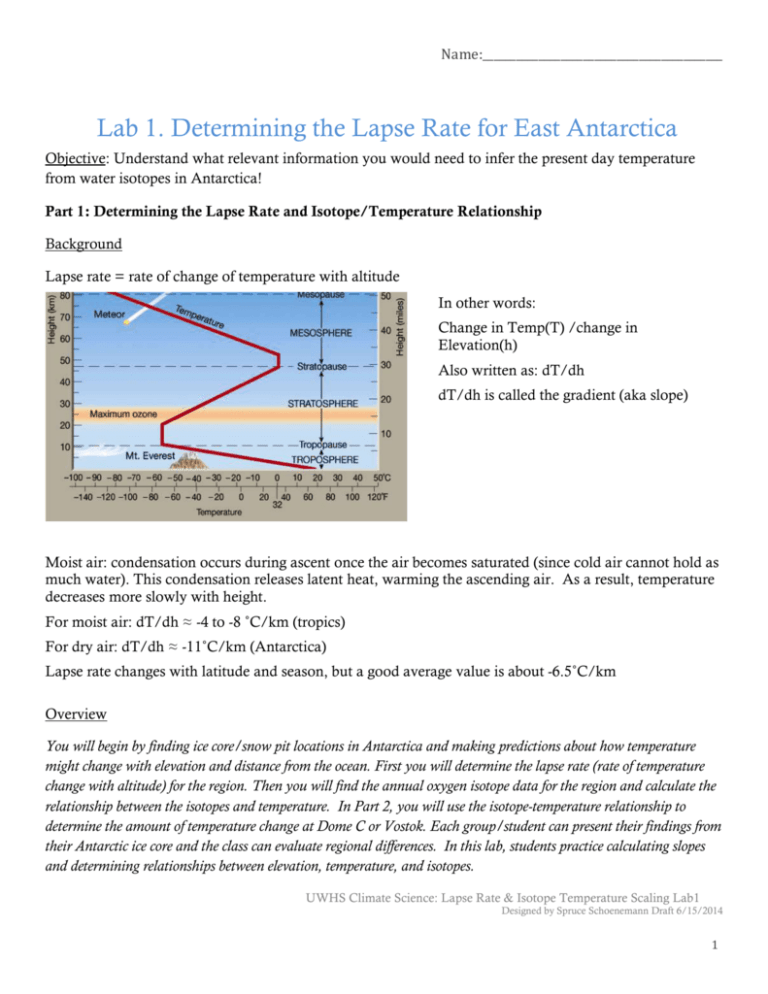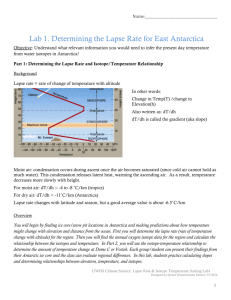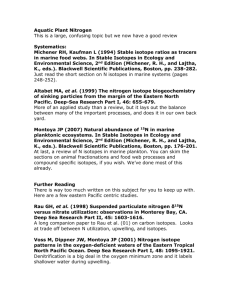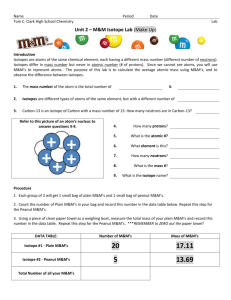Lab 1. Determining the Lapse Rate for East Antarctica
advertisement

Name:___________________________________________ Lab 1. Determining the Lapse Rate for East Antarctica Objective: Understand what relevant information you would need to infer the present day temperature from water isotopes in Antarctica! Part 1: Determining the Lapse Rate and Isotope/Temperature Relationship Background Lapse rate = rate of change of temperature with altitude In other words: Change in Temp(T) /change in Elevation(h) Also written as: dT/dh dT/dh is called the gradient (aka slope) Moist air: condensation occurs during ascent once the air becomes saturated (since cold air cannot hold as much water). This condensation releases latent heat, warming the ascending air. As a result, temperature decreases more slowly with height. For moist air: dT/dh ≈ -4 to -8 ˚C/km (tropics) For dry air: dT/dh ≈ -11˚C/km (Antarctica) Lapse rate changes with latitude and season, but a good average value is about -6.5˚C/km Overview You will begin by finding ice core/snow pit locations in Antarctica and making predictions about how temperature might change with elevation and distance from the ocean. First you will determine the lapse rate (rate of temperature change with altitude) for the region. Then you will find the annual oxygen isotope data for the region and calculate the relationship between the isotopes and temperature. In Part 2, you will use the isotope-temperature relationship to determine the amount of temperature change at Dome C or Vostok. Each group/student can present their findings from their Antarctic ice core and the class can evaluate regional differences. In this lab, students practice calculating slopes and determining relationships between elevation, temperature, and isotopes. UWHS Climate Science: Lapse Rate & Isotope Temperature Scaling Lab1 Designed by Spruce Schoenemann Draft 6/15/2014 1 Name:___________________________________________ Instructions You will focus in on the latitudinal transect highlighted in the orange circle in East Antarctica, that goes from the coast at Shackleton to the interior at Vostok. Note: A second transect can be calculated from the coast near the Shackleton Ice Shelf to the interior at Vostok Station circled in red. First, you will want to look at the Antarctic Elevation data (Map 1a). 1) Determine the elevation at the coast: __________ and the elevation at Vostok: __________. The difference between these two values will be the elevation gradient (for example 20-2000m= 1880m). The change in elevation (dh) is _________(m) Map 1a. Important: When reading the color bar values, make sure you consistently read the numbers from the same location on the color box. For example, 0 m would be the BOTTOM of the dark purple, so the value of the next dark blue box would be 500 m, NOT 1000 m. For neg. values in Map 1b, you would read the # from the BOTTOM of the box, so the red box would be –10˚C. UWHS Climate Science: Lapse Rate & Isotope Temperature Scaling Lab1 Designed by Spruce Schoenemann Draft 6/15/2014 2 Name:___________________________________________ 2) Then look at the Annual Mean Temperature data (Map 1b.). Determine the temperature at the coast: ________, and the temperature at Vostok: _________. The difference between the two temperature values will be the temperature gradient (for example –40 to –10 = –30˚C). The change in temperature (dT) is __________ (˚C). Map 1b. 3) Now calculate the lapse rate for the Shackleton-Vostok transect. To do this you need to divide the change in temperature (dT) by the change in elevation (dh). East Antarctic Lapse Rate: _________/_________= _________ (˚C) /(km) *Convert meters to km* What does the East Antarctic Lapse Rate tell you? (Hint: For every 1 km increase in elevation, the temperature __________ by ____˚C)? Does this lapse rate indicate a moist climate or a dry climate, why? (Refer to beginning of lab) UWHS Climate Science: Lapse Rate & Isotope Temperature Scaling Lab1 Designed by Spruce Schoenemann Draft 6/15/2014 3 Name:___________________________________________ Next, you will continue with a map of real ice core and snow pit data collected from Antarctica at the same locations as the temperature data (see below) to calculate the change in isotopes (dI)/change in elevation (dh). Map 2. 4) Determine the oxygen isotope value at Shackleton: _________ per mil, and the oxygen isotope value at Vostok: _________ per mil. The difference between the two oxygen isotope values is the isotope gradient (for example -45 to -15 = -30 per mil). The change in isotopes (dI) is __________ (per mil). 5) Now calculate the isotope slope for the Shackleton-Vostok transect. To do this you need to divide the change in isotopes (dI) by the change in elevation (dh). East Antarctic Isotope Gradient: _________/_________= _________ (per mil/km) *Convert m to km* UWHS Climate Science: Lapse Rate & Isotope Temperature Scaling Lab1 Designed by Spruce Schoenemann Draft 6/15/2014 4 Name:___________________________________________ 6) Once you have determined the present day isotope gradient, you now have enough information to calculate the isotope/temperature relationship that we have been trying to find: ________ (per mil/km)/_______ (˚C/km) = _________ (per mil/˚C). At this point you are ready to open the Lapse Rate Isotope Temp Lab1.xlsx. Enter the data your group collected above into the table labeled “Determining the Lapse Rate and Isotope/Temperature Relationship”. You should have changes in elevation (dh), temperature (dT), and isotope (dI) values for each column. Once all the groups have entered data, we can calculate the class averages. Meanwhile, move on to Step 2. In Step 2, I have provided the actual traverse data for Dome C and Vostok. Compare your estimates from above with the actual data for whichever core you are working on. 1) Plot Temperature vs. Elevation. Then add a linear trend line to determine the slope (dT/dh). At the bottom of the traverse data (C52), enter the slope for dT/dh. Convert meters to km. 2) Plot δ18O vs. Elevation. Then add a linear trend line to determine the slope (dI/dh). At the bottom of the traverse data (E52), enter the slope for dI/dh. Convert meters to km. 3) Use the two slopes from above to determine the isotope/temperature relationship for Vostok. Remember the units for the gradient are (per mil/˚C) as elevation cancels out!!! ______________________________________________________________________________________ Part 2. Modern Isotope/Temperature scaling to infer PAST temperature change! Now you can use the isotope/temperature relationship (per mil/˚C) to infer the temperature changes recorded in the oxygen isotopes in the deep ice cores from Antarctica. Here we will use 800,000 years of δ18O (‰) data from the EPICA (European Project for Ice Coring in Antarctica) Dome C Ice Core. Background Water molecules are made up of two hydrogen atoms and one oxygen atom. Hydrogen has two common isotopes, normal hydrogen (H) and the heavier deuterium (2H). Oxygen also has two common isotopes, the normal 16O and the heavier 18O. Water molecules can occur in a number of combinations of hydrogen and oxygen isotopes, like H216O, H218O, 2H216O or even 2H218O. For this exercise we are going to focus on the oxygen isotopes of the water molecule. Differences in the amount of these oxygen isotopes in a water molecule are measured by using the ratio of 18O/16O. The amount of 18O/16O in a water sample is compared to the known 18O/16O ratio of average ocean water (called VSMOW). This comparison is called UWHS Climate Science: Lapse Rate & Isotope Temperature Scaling Lab1 Designed by Spruce Schoenemann Draft 6/15/2014 5 Name:___________________________________________ δ18O (pronounced “delta-18-O”). Variations in the δ18O of the oxygen in the water molecule are useful in understanding the hydrological cycle. Average ocean water has a δ18O value of 0‰ (‰ is pronounced per mil and is the symbol for one-thousandth, just like %, or percent, which is the symbol for one-hundredth). Instructions Follow the instructions below. The same instructions are in each tab of the Excel file. Open the Excel spread sheet DomeC_d18O_UWHS_Lab1.xlsx Click on Tab 3: Understanding the Data For the first part of this exercise, you will need to use the Dome C δ18O isotope data and convert it to a temperature using the isotope/temperature relationship you determined from Part 1. of the lab. In Column B, you have the Age of the ice before present, where the present has been defined as 1950. This is written as Age (year BP 1950). In Column C, you have the Dome C δ18O isotope data in per mil. 1) Plot the δ18O isotope (column C) data vs. Age (column B) Convert Isotopes to Temperature Click on Tab 2: Temperature Conversion 1) Use the isotope/temperature relationship that you determined in Lab 1 to convert the δ18O isotope values to temperature values. Put the value in the red box: 2) In Column E, divide the δ18O data (column C) by the isotope-temp relationship (red box value) under the heading "Temperature Scaling" (green box). 3) Plot the new temperature anomaly data versus age Calculate the Average Temperature and Anomaly from the past 1,000 years Click on Tab 5: Temperature Anomaly 1) Calculate the average temperature for the past 1,000 years BP from Column E 1a) Insert the value in the red box: UWHS Climate Science: Lapse Rate & Isotope Temperature Scaling Lab1 Designed by Spruce Schoenemann Draft 6/15/2014 6 Name:___________________________________________ 2) In Column G (Labeled Temperature Anomaly), calculate the temperature anomaly (difference between average (1000 years) temperature and δ18O data) 3) Graph the new temperature anomaly data (column G) versus age (column B) Temperature Anomaly and Proxy Data Comparison Click on Tab 6: CO2 1) Compare the variations of CO2 data to the temperature anomaly. 2) What do you observe between the two records? Is there a strong or weak relationship? 3) Is it positively or negatively correlated (that is: does it go up and down together (pos) or opposite (neg))? 4) What is the largest CO2 change you observe? Answer should be (in ppmv) Click on Tab 7: Methane 1) Compare the variations of methane data to the temperature anomaly. 2) What do you observe between these two records? 3) Is there a strong or weak relationship? Is it positively or negatively correlated? 4) Is the relationship between methane and temperature closer than CO2 and temperature? 5) What processes do you think link methane and temperature? 6) Why would methane have a different response time than CO2? Click on Tab 8: Dust 1) Compare the variations of dust data to the temperature anomaly. 2) What do you observe between these two records? 3) Is there a strong or weak relationship? Is it positively or negatively correlated? 4) Provide an explanation for why dust varies the way it does between glacial-interglacial periods UWHS Climate Science: Lapse Rate & Isotope Temperature Scaling Lab1 Designed by Spruce Schoenemann Draft 6/15/2014 7 Name:___________________________________________ Click on Tab 9: Insolation 1) Compare the variations of insolation (incoming radiation) data to the temperature anomaly. How large are the insolation anomalies? 2) During which periods of insolation do you find lower temperatures? High temperatures? 3) Are there any obvious periodicities (recurring spacing between peaks)? 4) Is there a strong or weak relationship? Is it positively or negatively correlated? 5) Do you observe any lags (delays) in the temperature response to orbital forcing? 6) Why do you think temperature may not directly track the amount of solar radiation? UWHS Climate Science: Lapse Rate & Isotope Temperature Scaling Lab1 Designed by Spruce Schoenemann Draft 6/15/2014 8







